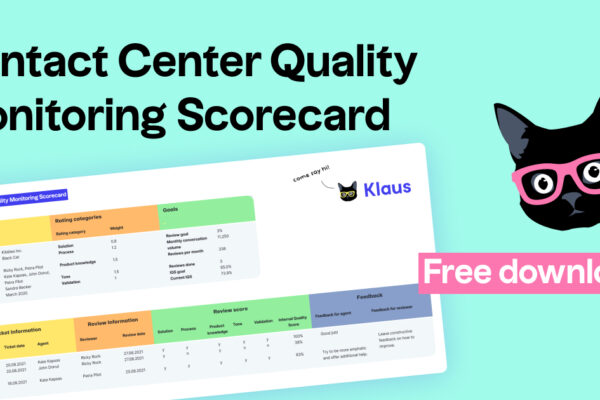Improving contact center performance naturally becomes more manageable with fewer tasks to juggle. While it may seem daunting to achieve this, there’s a simpler solution than hiring agents and risking lower support quality: Automated quality assurance for contact centers.
But, first things first…
What does (automated) quality assurance mean for contact center?
Contact center quality assurance (QA) is the practice of reviewing and analyzing customer conversations to improve your team’s performance and overall support process.
By rating performance and processes based on your QA scorecard, you can provide data-driven feedback to your contact center agents and find areas for improvement. It’s an ongoing process that helps you keep up with rising customer expectations.
The good news is, your quality assurance process can now be automated. This way, you can understand your contact center employee performance and customers’ frustrations without having to dig into all the support conversations manually.
Manual vs. automated quality assurance for contact centers
Manual reviews still play a crucial role in the quality assurance process for customer service. The human element — like your QA specialist — is crucial for interpreting complex situations, offering detailed feedback, and realizing the full potential of automated quality management & AI.
However, the most challenging aspect of the feedback loop also stems from human behavior:
- Limited scope: On average, only 2% of conversations are reviewed manually.
- Unconscious bias: Reviewers might harbor biases they’re not aware of, which can lead to skewed evaluations and unjust feedback.
- Scalability issues: Manual reviews don’t easily scale with the growing volume of customer interactions, potentially delaying feedback and impeding service improvements.
- Human error: It’s unavoidable and can result in flawed assessments and unreliable data.
- Inconsistency: Different reviewers might have varying criteria or perceptions of what excellent customer service looks like.
- Time-intensive: Manual reviewing can be laborious, especially as your volume of tickets grows, which can have a ripple effect on your operational costs.
When you think about it, manually sifting through conversations to identify issues often feels like using a metal detector on a beach in hopes of finding treasure. It’s time-consuming and exhausting, with no guaranteed payoff. Automated quality assurance for contact center acts like a treasure map, pointing you directly to the problem areas.
Because of that, automation and manual efforts aren’t mutually exclusive.

Why is automated quality assurance important for contact centers?
Support teams often engage in hundreds of daily interactions, creating a sea of data too vast to explore conversation by conversation without getting bogged down. The return on time invested in such detailed scrutiny isn’t justified. What really matters are the overarching trends.
Automated reviews can analyze a large volume of interactions – and do it fast. In fact, automated contact center QA can amplify your conversation review capabilities by up to 50 times, offering 100% coverage. This allows you to gauge the overall customer sentiment and team performance without opening each individual ticket, irrespective of the volume of interactions.

Not to mention that many of your customer interactions are quite routine. They don’t contain the level of complexity that needs individual examination. For example, a simple exchange between an agent and a customer to resolve a common issue doesn’t provide new insights into support processes. Spending time to review and rate such a conversation on a scorecard with numerous categories is inefficient.
However, understanding the basic elements of these routine interactions is crucial when you look at conversation quality from a statistical perspective. Questions like, how often do agents lapse into poor grammar? Or, how many conversations are not concluded appropriately? become valuable in this broader context. AI-powered tools like Klaus’ AutoQA can label and score these conversations with the details that matter.
Here’s how Klaus automates contact center QA:
- Every support interaction can be processed by Klaus’ proprietary ML engine for an instant understanding of your support landscape.
- Auto-scoring every agent and support interaction across multiple categories and languages means that you can achieve 100% coverage
- Klaus acts less like an assistant and more like a coworker. There is no model training required with our plug & play solution, simply step in and get to work.

How to build a contact center quality assurance program?
As already mentioned, part of automated quality assurance for contact center is about balancing AutoQA with manual effort. Here’s how to come up with a strategic QA framework to make sure that every customer interaction is a positive one.
Contact center quality assurance – best practices
- Start with a clear vision for your customer interactions
- Define quality assurance criteria for your contact center to build the best QA scorecard
- Decide who will review conversations (managers, QA specialists, peers, or agents themselves?)
- Choose how many (and which) conversations to review — or let the AI tools do it for you
- Make good use of your review feedback
1. Start with a clear vision for your customer interactions
Contact centers are not a one-size-fits-all solution; they should be tailored to your company’s unique objectives and values. When crafting a quality assurance process for your contact center, consider the following:
- Mission. Whatever sets you apart, the customer service you offer should consistently reflect that unique quality. It’s crucial to train and retain agents who can deliver this level of service effectively.
- Target audience. You have a choice here — whether to extend your services equally to all users, including trial members and leads or to focus mainly on paying or premium customers, for example.
- Approach. Your service style might prioritize quick and concise responses, and that’s perfectly fine. However, the landscape is shifting. While straightforward answers can be found in FAQs or provided by chatbots, customer service agents are expected to go above and beyond, fostering support-driven growth.
With these considerations in mind, your vision for your contact center could range from We offer excellent phone support to all to Our contact center focuses on premium customers, solving their problems while promoting product engagement and upsells via email and live chat.
The direction you choose will shape your quality assurance process, providing you with data-driven insights that inform agent training programs, guide coaching sessions, and ultimately influence your key performance indicators (support KPIs).

2. Define quality assurance criteria for your contact center
The process of setting goals is often rushed, yet it’s essential for aligning your reviews with your broader customer support vision. Don’t overlook this step.
To (eventually) build a QA scorecard that accurately reflects your team’s performance in terms of your service quality standards, this step involves four key elements:
Setting objectives
Revisit your support vision and distill it into 2-4 specific customer service goals. Whether your focus is on improving customer satisfaction, providing faster service, or improving your agents’ product knowledge, such objectives will guide you through contact center evaluations. They’ll also promote team alignment and allow you to pivot strategies as necessary.
Choosing relevant QA categories
Once you’ve set your objectives, you can build your own QA scorecard — an evaluation form that helps in an objective assessment of customer conversations. Pair each of your objectives with at least one rating category on your scorecard.
Categories can range from Solution, Tone, Empathy, Following internal processes, or Going the extra mile. For example, if you aim to improve agents’ product knowledge, include Provided accurate product information as a scorecard category. If, on the other hand, you want to make customer interactions feel warmer and friendlier, you should include a category for Empathy.
Interestingly, the average number of rating categories on a scorecard is 14 (although the median is a far more reasonable 8).
Prioritizing rating categories (if needed)
Again, refer back to your vision, objectives, and overarching customer service strategy to identify the rating categories that hold the most significance to your quality standards. Assign greater weight to these categories in your internal evaluations.
For example, if accurate product information is a higher priority than an agent’s choice of words, then give it more weight on your scorecard. You may also designate certain categories as “critical,” meaning they must be passed for the conversation to receive an overall passing grade.

Agreeing upon a rating scale
Establish a scoring system that’s straightforward and easily understood by all reviewers, ensuring consistent evaluations across the board. This could be as simple as a 2-point scale, where reviewers can only give a thumbs-up or thumbs-down for each rating category. Alternatively, it could be a more nuanced scale, like a score out of 10.
According to Customer Service Quality Benchmark Report 2023, many teams use a binary rating scale to rate categories on a scorecard, although rating scales can be far more granular:
- 2-point rating scale is used by 47.3% of surveyed customer support professionals
- 3-point rating scale — 35.3%
- 5-point rating scale — 10.9%
- 4-point rating scale — 6.5%
Your contact center scorecard is the cornerstone of your QA process, so investing time in its creation is crucial. Skipping the steps of vision and goal-setting could lead to evaluation criteria that don’t align with your contact center’s needs.
3. Decide who will review conversations
Choose between managers, QA specialists, peers, and self-reviews. They all have their pros and cons, so see which one works best for you:
- Managers can handle only a limited number of case reviews, but their input is valuable for understanding team strengths and weaknesses as well as broader processes.
- QA Specialists prioritize measuring and improving quality across the board. Having someone focused solely on this ensures that it doesn’t get sidelined amid other tasks.
- Peer Reviews are time-efficient and foster a culture of learning from one another. When paired with team calibration sessions, they are excellent for establishing common standards.
- Self-Reviews enable agents to identify their areas for growth, crucial for their professional development. While uncommon as a standalone method, they are particularly useful when incorporated into performance evaluations.
4. Choose which conversations to review
You can focus on:
- Interactions that are complex (e.g. involved extended back-and-forth and no straightforward solution),
- Conversations handled by new agents as part of their onboarding and training,
- Support tickets where the customer left a poor Customer Satisfaction (CSAT) score,
- Calls over messages, if phone is your main support stream.
If you’re looking for a numerical target, framing your goal as a percentage of total Ticket Volume can keep your QA reviews statistically relevant, especially as your contact center grows.
When you want to monitor customer service, the inclination is to want to know everything. But you don’t want to – and don’t have time to – review everything. So when it comes to reviewing, sampling is everything. With Klaus, you have an automatic evaluation of the more uncreative themes, with the critical sampling done for you repeatedly, automatically, and effortlessly. – Mervi Sepp Rei, PhD, Klaus
Here’s when automation really shines. As you might remember, AI-powered solutions like Klaus can highlight complex conversations that fall into the must-review category, and reveal the greatest learning opportunities for you and your agents. Klaus’ AutoQA, on the other hand, can automatically score every agent and support interaction across multiple categories and languages.

5. Make good use of your review feedback
Leverage the insights you gain from customer interactions in meaningful ways — either as feedback to your agents or as valuable data for other departments.
Before you delve into your contact center interactions, strategize how you’ll apply the information you collect. Rather than viewing quality monitoring as a fault-finding mission, see it as an avenue for team growth via constructive feedback.
You can, for example, use conversation reviews to provide tailored feedback to your agents during one-on-one meetings. Identify their growth opportunities and establish specific, time-sensitive goals, then monitor how they evolve from one support interaction to the next.
Consider automated quality assurance for your contact center
Creating a structured QA process for your contact center is vital for monitoring your team’s long-term performance and offering consistent feedback to your agents. The easier, more adaptable, and more transparent the contact center quality assurance program is for everyone involved, the higher the likelihood of active participation.
While many companies initially rely on spreadsheets to coordinate their internal feedback systems, this approach can quickly become unmanageable and hard to scale.
Specialized quality management solutions like Klaus can dramatically cut down on administrative overhead and make automated quality assurance for contact centers more efficient.



![Download The Future of Conversations [ebook]](https://storage.googleapis.com/static_site_bucket/1000b88a-klaus-gdb00_1b-1413x630-1.png)


